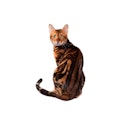Bengal Cat Breed

- Size
- Medium to large with males: 10 to 18 pounds and females: 6 to 12 pounds
- Coat
- Medium
- Color
- Bright orange to light brown, with dark spots or a distinctive marbling pattern
Bengal Cats are curious and confident with the tameness of a domestic tabby and the beauty of an Asian Leopard Cat. Learn more about Bengals and their playful personality, plus information on their health and how to feed them.
Characteristics
Bengal Cats have an athletic appearance with well-defined muscles, creating a lean, balanced appearance. They feature high cheekbones, dark markings around the eyes and the ears are small and pointed but round at the tips. Their coats have a unique, plush feel unlike any other cat breed.
Lifespan
12 to 16 years
Colors
One of the most distinctive features of this feline is its unique coat pattern and color. Most Bengal Cats’ coats have rich, highly contrasted shades of bright orange to light brown, with dark spots or a distinctive marbling pattern. Some even have a “glitter” to the tips of their fur, which glistens when the light hits it.
Shedding
A Bengal is fairly low maintenance. She won’t shed much and is an efficient self-groomer.
Health
Although responsible breeders make every effort to avoid health complications and genetic disorders in their felines, there are some conditions you should be aware of.
Bengals may suffer from distal neuropathy and flat-chested kitten syndrome, both of which typically resolve on their own as the kitties mature. As they age, Bengals may develop other problems like hip dysplasia, hypertrophic cardiomyopathy, patellar luxation and progressive retinal atrophy.
Choosing the Best Food for Bengal Cats
Because of their energetic nature, Bengals need a complete and balanced cat food rich in protein, such as Pro Plan Complete Essentials or Pro Plan True Nature dry and wet food. Always consult with your veterinarian if you have any questions or concerns, and slowly transition your feline companions to a new food to avoid digestive upset.
To explore other products for your Bengal Cat, see our Product Selector.
Choosing the Best Food for Bengal Kittens
Bengal kittens need additional nutrients to support their growth and development. Consider a kitten food like Pro Plan Development Kitten dry and wet products or Pro Plan True Nature Kitten Grain Free dry and wet products to provide your kitty everything she needs to reach her full potential.
History
The Bengal Cat is a hybrid of a domestic cat with the wild Asian Leopard Cat. The first crossbreed was performed by Jean Mill in 1963, but the hybrid wasn’t perfected until the mid-1980s. Today, Bengals are bred only with each other.
Facts
The Bengal Cat’s name comes from the scientific name for the Asian Leopard Cat, Prionailurus bengalensis.
- Bengals are the only domestic cat with rosettes that resemble the markings on leopards, jaguars and ocelots.
- The International Cat Association (TICA) accepted the Bengal for championship status in 1991 and the American Cat Fanciers Association (ACFA) accepted the breed shortly thereafter.
- The ACFA rescinded their acceptance after second-generation felines reportedly caused problems at cat shows. The Bengal was reinstated to ACFA in 1997 with the caveat that any cats shown had to be fifth generation.